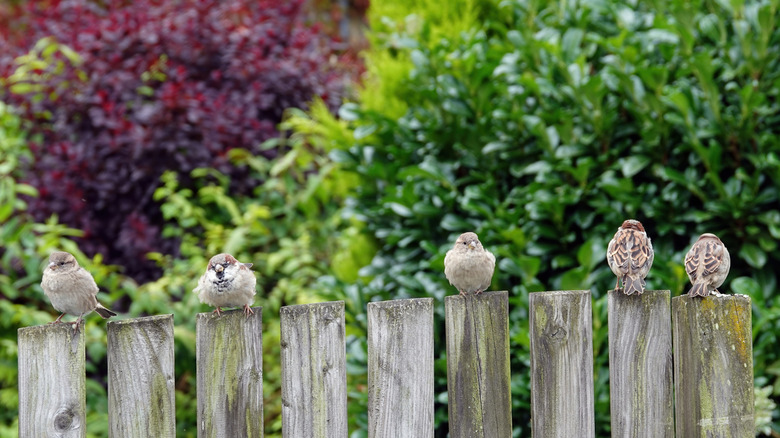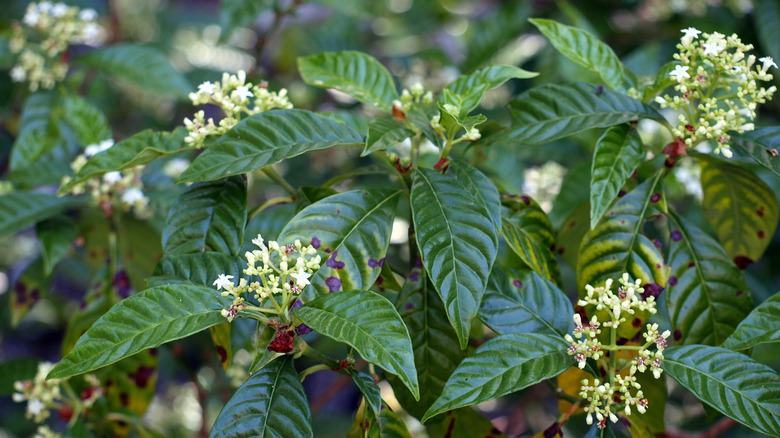The Fast-Growing Evergreen Plant That Birds And Butterflies Find Irresistible
On the look for shrubs that will attract birds to your yard for fun feathered sightings — and other winged critters, too? These plants have commonalities that make them ideal for bird and butterfly-friendly yards. They're botanical supermarkets — they have berries, buds, and nectar-filled blooms, and host delicious (for our avian friends, at least) insects. Being endemic to the area, they have co-evolved with local bird and butterfly species and benefit one another. One example is bird-distributed seeds; another is tube-shaped flowers adapted to the long proboscis of butterflies. They vary in height and density, providing shelter and protection from predators to suit birds large and small, migratory or non-migratory. It just so happens that there's a North American native evergreen shrub that ticks the boxes on all these criteria: wild coffee. What's more, it grows fast, allowing you to bolster the bird attracting capabilities of your garden right away.
Wild coffee (Psychotria nervosa) also goes by the common name Seminole balsamo. Despite the plant's common name, the berries aren't a coffee substitute; they don't contain caffeine. Though, as a madder (Rubiaceae) family plant, they are cousins. Wild coffee is native to Florida in the U.S. — Peninsular Florida into the Keys, specifically — and also the Caribbean, Central America, and northern South America. Given this range, it perhaps comes as no surprise that gardeners in USDA Hardiness Zones 9a through 11 can grow it outdoors. In the wild, it grows in forests and shrublands, but in home gardens, this pretty shrub is more often used as a specimen or accent plant or in hedges.
What makes wild coffee such a powerful butterfly and bird attracting plant?
Wild coffee attracts butterflies to your garden with its abundant white to slightly green-hued blooms. The evergreen shrub blooms all year round in its growing zone, providing a ready source of nectar for spicebush swallowtail, atala, great southern white, julia, and Schaus' swallowtail butterflies. The red berries, which appear on the plant between December and March, are a magnet for cardinals, mockingbirds, catbirds, blue jays, and hummingbirds, in particular.
Wild coffee matures in three to five years, though it usually flowers after two, traits ideal for gardeners impatient to establish a bird and butterfly garden — if, say, you've recently moved into a new property or landscaped an existing backyard. It's also easy to grow, another bonus for the less green-fingered but feather and exoskeleton-enthused. Unlike many flowering shrubs, it grows best in partial to full shade; the leaves turn yellow in sunlight. Wild coffee thrives in poor — though not salty — soils and is mostly pest-free (outside of rare soft scale infestations). There's even a dwarf cultivar called Psychotria nervosa 'Little Psycho' for those with small backyards or container gardens.
Of course, choosing between native and non-native plants is more complicated than you think. You need to consider whether wild coffee is suitable for your backyard before heading to the store — after all, a shrub in a 3-gallon pot will set you back $22 at Florida Native Plants, while a packet of 10 seeds costs $4 at Sola Seed Company. However, if you know someone with a thriving wild coffee, the plant is easy to propagate from cuttings, and it self-seeds.

